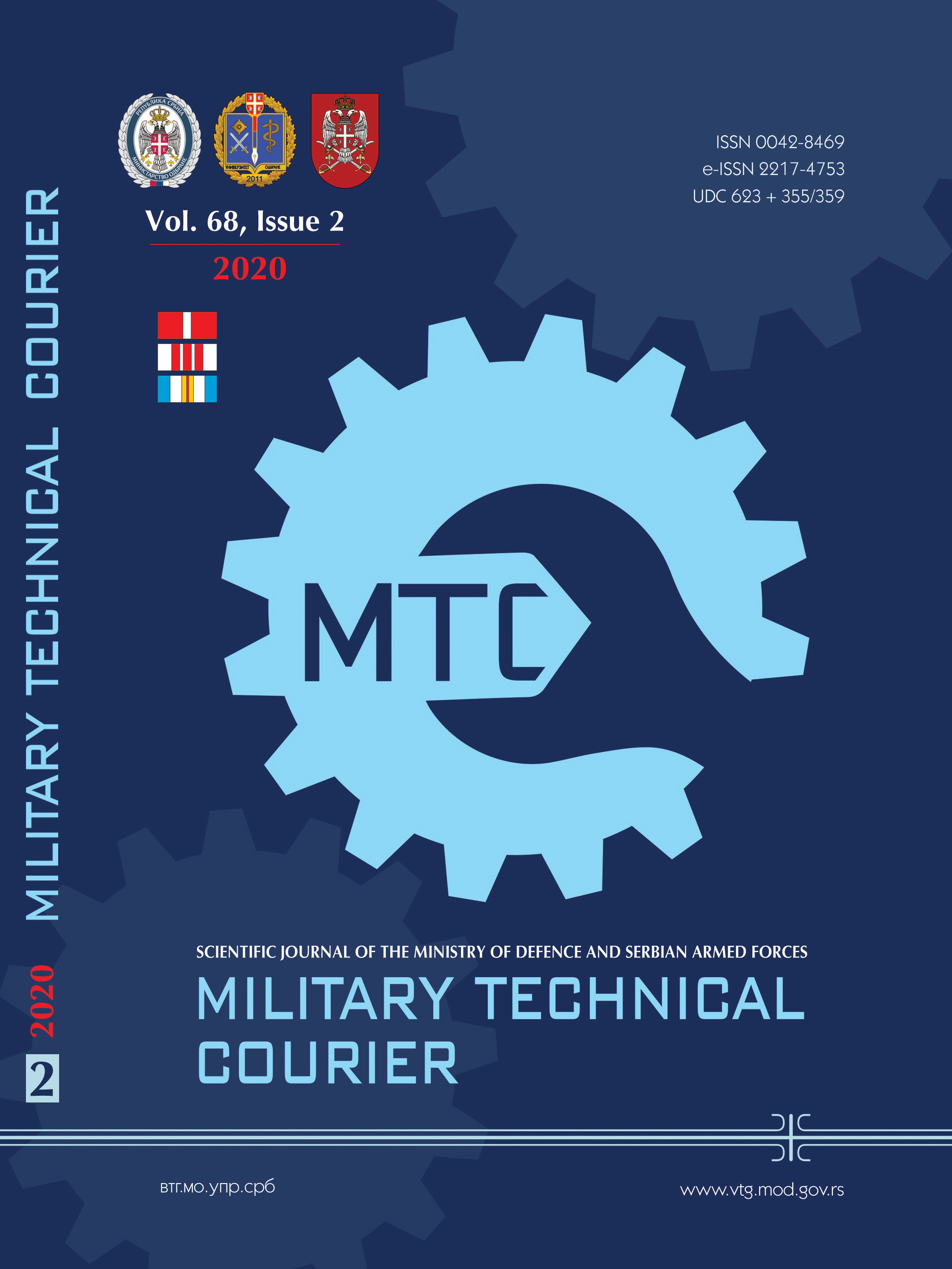Improved chemical treatment of Sušica surface water, Zlatibor area, and sludge application
Abstract
Introduction/purpose: Sušica source surface water varies in natural organic and inorganic impurities, biological species and micro-organisms. This water is used instead of Vrutci lake water that has been stronglly affected by eutrophication. These waters need removal of pollutants with coagulants and polyelectrolyte. The aim of research was to improve the surface water treatment (coagulation and flocculation), to reduce sludge amount and to evaluate its quality, treatment and application.
Methods: The physical-chemical methods are developed for determining the quality parameters of water, sludge and compost. These parameters are: turbidity, KMnO4 consumption, metals, total organic carbon, total nitrogen, and chlorophyll.
Results: Surface water quality has a strong impact on sludge. The concentrations of metals in the sludge were: 72200 mgkg-1 Al, 8550 mgkg-1 Fe, and 106 mgkg-1 Zn. The metals over the maximum limit were: Ni 169 mgkg-1, Cr 69.5 mgkg-1, Pb 5.7 mgkg-1, and they have to be reduced by zeolite. The „nutrients” concentrations were: 697 mgkg-1 P, 297 mgkg-1 K, 9.6 mgkg-1 total N, and 274 mgkg-1 of dissolved organic carbon. Escherichia coli and Salamonella are important for converting sludge to compost.
Conclusions: After maturation, compost can be used for Coriandrum sativum cultivation. In further work, this strategy should be applied to the water and sludge from Vrutci lake.
References
Aguilar, M.I., Sáez, J., Lloréns, M., Soler, A., Ortuño, J.F., Meseguer, V., & Fuentes, A. 2005. Improvement of coagulation–flocculation process using anionic polyacrylamide as coagulant aid. Chemosphere, 58(1), pp.47-56. Available at: https://doi.org/10.1016/j.chemosphere.2004.09.008.
Christophoridis, C., Zervou, S-K., Manolidi, K., Katsiapi, M., Moustaka-Gouni, M., Kaloudis, T., Triantis, T.M., & Hiskia, A. 2018.. Occurrence and diversity of cyanotoxins in Greek lakes. Scientific Reports, 8, 17877. Available at: https://doi.org/10.1038/s41598-018-35428-x.
Cvijovic, M., Di Marco, V., Traldi, P., Stankov, M.J., & Djurdjević, P. 2012. Mass Spectrometric Study of Speciation in Aluminium–Fluoroquinolone Solutions. European Journal of Mass Spectrometry, 18(3), pp.313-322. Available at: https://doi.org/10.1255/ejms.1183.
Cvijović, M., Kilibarda, V., Jelikić-Stankov, M., Lazarević, I., Jakovljević, I. , Joksović, Lj., & Đurđević, P. 2012. ESI-MS study of speciation in hydryzed aluminium chloride solutions. Journal of the Brazilian Chemical Society, 23(6), pp.1087-1097. Available at: https://doi.org/10.1590/S0103-50532012000600013.
Čudić, V., Stojiljković, D., & Jovović, A. 2016. Phytoremediation potential of wild plants growing on soil contaminated with heavy metals. Archives of Industrial Hygiene and Toxicology, 67(3), pp.229-239. Available at: https://doi.org/10.1515/aiht-2016-67-2829.
Djurdjevic, P., Cvijovic, M., & Zakrzewska, J. 2005. Aluminium(III) complexes of S-histidine: synthesis, characterization and potentiometric and spectroscopic study of solution equilibria. Journal of Coordination Chemistry, 58(17), pp.1615-1629,Available at: https://doi.org/10.1080/00958970500258807.
-Institute for Standardization of Serbia. 2007. SRPS ISO 8245, 2007. Water quality - Guidelines for the determination of total organic carbon (TOC) and dissolved organic carbon (DOC) [online]. Available at: https://www.iss.rs/rs/standard/?natstandard_document_id=16793&is_print=1 [Accessed: 12 April 2020].
-Institute for Standardization of Serbia. 2013. SRPS ISO 1871:2013. Food and feed products - General guidelines for the determination of nitrogen by the Kjeldahl method [online]. Available at: https://www.iss.rs/en/standard/?national_standard_id=42530 [Accessed: 12 April 2020].
-Institute for Standardization of Serbia. 2017. SRPS Z.T1.100:2017. Specification for Composted Material [online]. Available at: https://www.iss.rs/rs/standard/?natstandard_document_id=60801.
Katsiapi, M., Moustaka-Gouni, M., Michaloudi, E., & Kormas, K.Ar. 2011. Phytoplankton and water quality in a Mediterranean drinking-water reservoir (Marathonas Reservoir, Greece). Environmental Monitoring and Assessment, 181, pp.563–575. Available at: https://doi.org/10.1007/s10661-010-1851-3.
Keeley, J., Jarvis, P., & Judd, S.J. 2014. Coagulant Recovery from Water Treatment Residuals: A Review of Applicable Technologies. Critical Reviews in Environmental Science and Technology, 44:24, pp.2675-2719. Available at: https://doi.org/10.1080/10643389.2013.829766.
Kerkez, Đ. 2014. Potencijal upotrebe piritne izgoretine u tretmanu otpadnih voda i mogućnost njene dalje sanacije primenom imobilizacionih agenasa. Ph.D. thesis. Novi Sad, Serbia: University of Novi Sad, Faculty of Science (in Serbian) [online]. Available at: http://nardus.mpn.gov.rs/bitstream/handle/123456789/1780/Disertacija.pdf?sequence=1&isAllowed=y [Accessed: 12 April 2020].
Malik, Q. 2018. Performance of alum and assorted coagulants in turbidity removal of muddy water. Applied Water Science, 8, 40. Available at: https://doi.org/10.1007/s13201-018-0662-5.
Meyers, P.S. 1998. Sources of TOC in Deionized Water [online]. Available at: http://www.pi-corp.net/whitepaper/SourcesofTOCinDIWater.pdf [Accessed: 12 April 2020].
Nishat Ashraf, S., Rajapakse, J., Dawes, L.A., & Millar, G.J. 2018. Coagulants for removal of turbidity and dissolved species from coal seam gas associated water. Journal of Water Process Engineering, 26, pp.187-199. Available at: https://doi.org/10.1016/j.jwpe.2018.10.017
Ranković, B., Simić, S., & Bogdanović, D. 2006. Phytoplankton as Indicator of Water Quality of Lakes Bubanj and Šumarice during Autumn. Kragujevac Journal of Science, 28, pp.107-114 [online]. Available at: https://www.pmf.kg.ac.rs/KJS/volumes/kjs28/kjs28rankovicsimic107.pdf [Accessed: 15 April 2020].
Ritchie, R.J. 2006. Consistent Sets of Spectrophotometric Chlorophyll Equations for Acetone, Methanol and Ethanol Solvents. Photosynthesis Research, 89(1), pp.27-41. Available at: https://doi.org/10.1007/s11120-006-9065-9.
Proposed Creative Commons Copyright Notices
Proposed Policy for Military Technical Courier (Journals That Offer Open Access)
Authors who publish with this journal agree to the following terms:
Authors retain copyright and grant the journal right of first publication with the work simultaneously licensed under a Creative Commons Attribution License that allows others to share the work with an acknowledgement of the work's authorship and initial publication in this journal.
- Authors are able to enter into separate, additional contractual arrangements for the non-exclusive distribution of the journal's published version of the work (e.g., post it to an institutional repository or publish it in a book), with an acknowledgement of its initial publication in this journal.
- Authors are permitted and encouraged to post their work online (e.g., in institutional repositories or on their website) prior to and during the submission process, as it can lead to productive exchanges, as well as earlier and greater citation of published work (See The Effect of Open Access).

